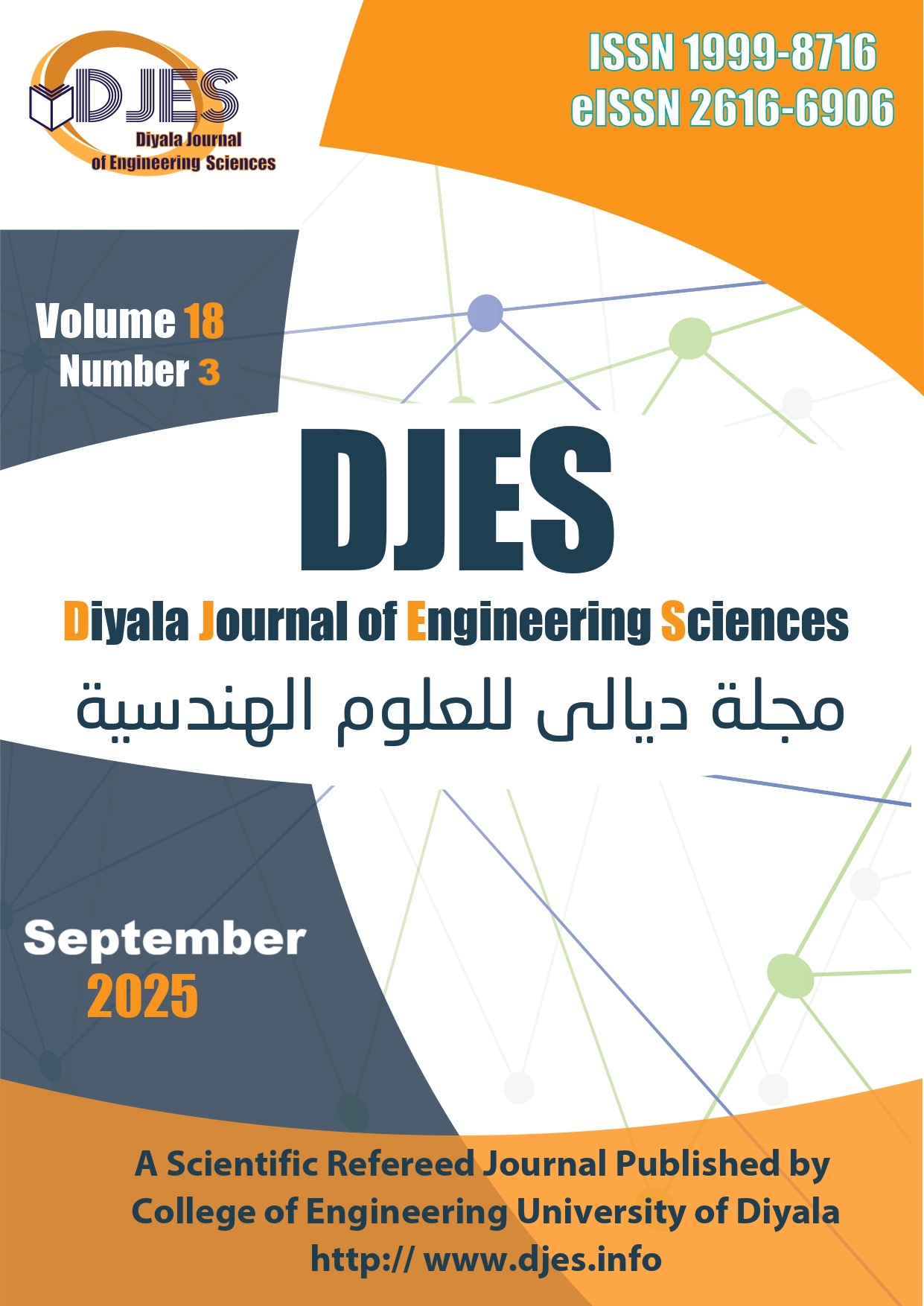Family Membership Detection from Palm-Skin Texture Using Transfer Learning: A New Kinship Approach
DOI:
https://doi.org/10.24237/djes.2025.18310Keywords:
Skin Texture, Deep Transfer Learning, EfficientNetB0, VGG16, Kinship DetectionAbstract
The detection of a person's membership in a family is crucial in many cases, and the need for it becomes urgent during and after wars and natural disasters. While DNA testing and facial images are common methods for kinship detection, they have limitations in certain scenarios. This paper presents an innovative approach to intrafamily kinship classification using palm skin texture images, a modality not previously explored for this purpose. Unlike conventional palm biometric verification aimed at individual identification, this research investigates inherited skin texture patterns to establish familial relationships. A hand palm dataset was created from the MKH (Mosul Kinship Hand) images dataset. It contains 332 segmented and annotated skin images from 84 individuals across 15 families, with multiple samples per person. Two deep convolutional neural network pre-trained models (VGG16 and EfficientNetB0) were used independently for feature extraction via transfer learning. Based on these features, neural network classifiers were designed to detect the membership of an individual to one of the given families. The results were evaluated using the appropriate metrics and gave a test accuracy of 96% by using EfficientNetB0 and 79% from VGG16. The findings of this study suggest that hand palm images may offer a promising and practical preliminary approach to kinship detection. The dataset utilized in this study is accessible upon request from the author to support reproducibility and encourage further research.
Downloads
References
[1] J. P. Robinson, M. Shao, and Y. Fu, “Survey on the Analysis and Modeling of Visual Kinship: A Decade in the Making,” IEEE Trans. Pattern Anal. Mach. Intell., vol. 2021, no. February, pp. 1–20, 2021. 10.1109/TPAMI.2021.3063078
[2] V. Oray and S. H. Katsanis, “Ethical considerations for DNA testing as a proxy for nationality,” Glob. Bioeth., vol. 32, no. 1, pp. 51–66, 2021. 10.1080/11287462.2021.1896454
[3] A. Real-Picado, L. Díaz, and C. Gomes, “Relevance of Genetic Identification and Kinship Analysis in Human and Natural Catastrophes—A Review,” Genealogy, vol. 7, no. 3, pp. 1–14, 2023. 10.3390/genealogy7030044
[4] M. C. Mzoughi, N. Ben Aoun, and S. Naouali, “A review on kinship verification from facial information,” Vis. Comput., vol. 41, no. 3, pp. 1789–1809, Feb. 2025. 10.1007/s00371-024-03493-1
[5] A. Abbas and M. Shoaib, “Kinship identification using age transformation and Siamese network,” PeerJ Comput. Sci., vol. 8, p. e987, Jun. 2022. 10.7717/peerj-cs.987
[6] S. Jaishankar, N. Jainshankar, and S. Shanmugam, “Lip Prints in Personal Identification,” Jiads, vol. 1, no. 4, pp. 23–26, 2010.
[7] A. Othmani, D. Han, X. Gao, R. Ye, and A. Hadid, “Kinship recognition from faces using deep learning with imbalanced data,” Multimed. Tools Appl., vol. 82, no. 10, pp. 15859–15874, 2023. 10.1007/s11042-022-14058-6
[8] E. O. AIGBOGUN, Jr, C. P. IBEACHU, and A. M. LEMUEL, “Fingerprint pattern similarity: a family-based study using novel classification,” Anatomy, vol. 13, no. 2, pp. 107–115, 2019. 10.2399/ana.19.065
[9] R. George, N. S. B. Nora Afandi, S. N. H. B. Zainal Abidin, N. I. Binti Ishak, H. H. K. Soe, et al., “Inheritance pattern of lip prints among Malay population: A pilot study,” J. Forensic Leg. Med., vol. 39, pp. 156–160, Apr. 2016. 10.1016/j.jflm.2016.01.021
[10] S. Mala, V. Rathod, S. Pundir, and S. Dixit, “Pattern self-repetition of fingerprints, lip prints, and palatal rugae among three generations of family: A forensic approach to identify family hierarchy,” J. Forensic Dent. Sci., vol. 9, no. 1, pp. 15–19, 2017. 10.4103/jfo.jfds_115_15
[11] S. Ibrahim Fathi and M. H. Aziz, “A Dataset for Kinship Estimation from Image of Hand Using Machine Learning,” Iraqi J. Electr. Electron. Eng., vol. 20, no. 2, pp. 127–136, 2024. 10.37917/ijeee.20.2.11
[12] M. R. Kiley and M. S. Hossain, “Who are My Family Members? A Solution Based on Image Processing and Machine Learning,” Int. J. Image Graph., vol. 20, no. 04, p. 2050033, Oct. 2020. 10.1142/S0219467820500333
[13] R. A. J. ALhatimi and S. Savaş, “Transfer Learning-Based Classification Comparison of Stroke,” Comput. Sci., vol. 55, no. 35, pp. 1–100, Sep. 2022. 10.53070/bbd.1172807
[14] N. Mohanty, M. Pradhan, A. V. N. Reddy, S. Kumar, and A. Alkhayyat, “Integrated Design of Optimized Weighted Deep Feature Fusion Strategies for Skin Lesion Image Classification,” Cancers (Basel)., vol. 14, no. 22, pp. 1–25, 2022. 10.3390/cancers14225716
[15] M. Tan and Q. V. Le, “EfficientNet: Rethinking model scaling for convolutional neural networks,” 36th Int. Conf. Mach. Learn. ICML 2019, vol. 2019-June, pp. 10691–10700, 2019.
[16] J. A. Alhijaj and R. S. Khudeyer, “Integration of EfficientNetB0 and Machine Learning for Fingerprint Classification,” Inform., vol. 47, no. 5, pp. 49–56, 2023. 10.31449/INF.V47I5.4724
[17] A. Zhou, Y. Ma, W. Ji, M. Zong, P. Yang, et al., “Multi-head attention-based two-stream EfficientNet for action recognition,” Multimed. Syst., vol. 29, no. 2, pp. 487–498, 2023. 10.1007/s00530-022-00961-3
[18] N. N. A. Zahrani and R. Hedjar, “Comparison Study Of Deep-Learning Architectures For Classification of Thoracic Pathology,” in 2022 13th International Conference on Information and Communication Systems (ICICS), 2022, pp. 192–198. 10.1109/ICICS55353.2022.9811150
[19] N. Kohli, “Automatic Kinship Verification in Unconstrained Faces using Deep Learning,” West Virginia University Libraries, 2019.
[20] X. Wu, X. Feng, X. Cao, X. Xu, D. Hu, et al., Facial Kinship Verification: A Comprehensive Review and Outlook, vol. 130, no. 6. Springer US, 2022. 10.1007/s11263-022-01605-9
[21] L. Zhang, Q. Duan, D. Zhang, W. Jia, and X. Wang, “AdvKin: Adversarial Convolutional Network for Kinship Verification,” IEEE Trans. Cybern., vol. 51, no. 12, pp. 5883–5896, 2021. 10.1109/TCYB.2019.2959403
[22] M. Bordallo Lopez, A. Hadid, E. Boutellaa, J. Goncalves, V. Kostakos, et al., “Kinship verification from facial images and videos: human versus machine,” Mach. Vis. Appl., vol. 29, no. 5, pp. 873–890, 2018. 10.1007/s00138-018-0943-x
[23] D. Hettiachchi, S. Hosio, V. Kostakos, N. van Berkel, M. B. López, et al., “Augmenting automated kinship verification with targeted human input,” Proc. 24th Pacific Asia Conf. Inf. Syst. Inf. Syst. Futur. PACIS 2020, pp. 1–14, 2020.
[24] F. Liu, Z. Li, W. Yang, and F. Xu, “Age-Invariant Adversarial Feature Learning for Kinship Verification,” Mathematics, vol. 10, no. 3, 2022.
[25] R. Fang, A. C. Gallagher, T. Chen, and A. Loui, “Kinship classification by modeling facial feature heredity,” in 2013 IEEE International Conference on Image Processing, 2013, pp. 2983–2987. 10.1109/ICIP.2013.6738614
[26] P. Alirezazadeh, A. Fathi, and F. Abdali-Mohammadi, “Effect of Purposeful Feature Extraction in High-dimensional Kinship Verification Problem,” J. Comput. Secur., vol. 3, no. 3, pp. 183–191, 2016.
[27] A. Chergui, S. Ouchtati, S. Mavromatis, S. E. Bekhouche, J. Sequeira, et al., “Kinship verification through facial images using multiscale and multilevel handcrafted features,” J. Electron. Imaging, vol. 29, no. 02, p. 1, 2020. 10.1117/1.jei.29.2.023017
[28] F. Zekrini, H. Nemmour, and Y. Chibani, “Feature Fusion for Kinship Verification Based on Face Image Analysis,” in Lecture Notes in Networks and Systems, vol. 413 LNNS, Springer International Publishing, 2022, pp. 486–494. 10.1007/978-3-030-96311-8_45
[29] X. Qin, X. Tan, and S. Chen, “Tri-Subject Kinship Verification: Understanding the Core of A Family,” IEEE Trans. Multimed., vol. 17, no. 10, pp. 1855–1867, 2015. 10.1109/TMM.2015.2461462
[30] K. Sudhakar and P. Nithyanandam, “Facial identification of twins based on fusion score method,” J. Ambient Intell. Humaniz. Comput., no. 0123456789, Mar. 2021. 10.1007/s12652-021-03012-3
[31] W. Wang, S. You, S. Karaoglu, and T. Gevers, “Kinship Identification through Joint Learning Using Kinship Verification Ensembles,” Lect. Notes Comput. Sci. (including Subser. Lect. Notes Artif. Intell. Lect. Notes Bioinformatics), vol. 12367 LNCS, pp. 613–628, Apr. 2020. 10.1007/978-3-030-58542-6_37
[32] H. Yan and J. Hu, “Video-based kinship verification using distance metric learning,” Pattern Recognit., vol. 75, pp. 15–24, Mar. 2018. 10.1016/j.patcog.2017.03.001
[33] H. K. Brustad, M. Colucci, M. A. Jobling, N. A. Sheehan, and T. Egeland, “Strategies for pairwise searches in forensic kinship analysis,” Forensic Sci. Int. Genet., vol. 54, no. March, p. 102562, 2021. 10.1016/j.fsigen.2021.102562
[34] M. A. Kaljahi, P. Shivakumara, T. Hu, H. A. Jalab, R. W. Ibrahim, et al., “A geometric and fractional entropy-based method for family photo classification,” Expert Syst. with Appl. X, vol. 3, p. 100008, Sep. 2019. 10.1016/j.eswax.2019.100008
[35] K. Zhang, Y. Huang, C. Song, H. Wu, and L. Wang, “Kinship Verification with Deep Convolutional Neural Networks,” in Procedings of the British Machine Vision Conference 2015, 2015, pp. 148.1-148.12. 10.5244/c.29.148
[36] R. K. Khalaf, “Facial Kinship Verification in Forensic Investigation Using Deep Neural Networks Abstract :,” J. Univ. Kerbala, vol. 2, no. 1, pp. 42–51, 2024.
[37] C. Bisogni and F. Narducci, “Kinship recognition: how far are we from viable solutions in smart environments?,” Procedia Comput. Sci., vol. 198, no. 2018, pp. 225–230, 2022. 10.1016/j.procs.2021.12.232
[38] X. Wu, E. Granger, T. H. Kinnunen, X. Feng, and A. Hadid, “Audio-Visual Kinship Verification in the Wild,” in 2019 International Conference on Biometrics (ICB), 2019, pp. 1–8. 10.1109/ICB45273.2019.8987241
[39] E. B. K. Liagre, M. L. P. Hoogland, and S. A. Schrader, “It runs in the family: Kinship analysis using foot anomalies in the cemetery of Middenbeemster (Netherlands, 17th to 19th century),” Int. J. Osteoarchaeol., no. January, pp. 1–14, 2022. 10.1002/oa.3100
[40] S. Loganadan, M. Dardjan, N. Murniati, F. Oscandar, Y. Malinda, et al., “Preliminary Research: Description of Lip Print Patterns in Children and Their Parents among Deutero-Malay Population in Indonesia,” Int. J. Dent., vol. 2019, pp. 1–6, Mar. 2019. 10.1155/2019/7629146
[41] G. OBrien and K. Murphy, “Fingerprint patterns through genetics,” J. Emerg. Investig., vol. 2, no. December, pp. 1–5, 2020. 10.59720/20-012
[42] P. M. Arabi, G. Joshi, and N. Vamsha Deepa, “Performance evaluation of GLCM and pixel intensity matrix for skin texture analysis,” Perspect. Sci., vol. 8, pp. 203–206, 2016. 10.1016/j.pisc.2016.03.018
[43] A. J. Yousif and M. H. Al-Jammas, “Real-time Arabic Video Captioning Using CNN and Transformer Networks Based on Parallel Implementation,” Diyala J. Eng. Sci., vol. 17, no. 1, pp. 84–93, 2024. 10.24237/djes.2024.17108
[44] Y. Filali, H. El Khoukhi, M. A. Sabri, A. Yahyaouy, and A. Aarab, “Texture Classification of skin lesion using convolutional neural network,” in 2019 International Conference on Wireless Technologies, Embedded and Intelligent Systems (WITS), 2019, pp. 1–5. 10.1109/WITS.2019.8723791
[45] D. M. Aprilla, F. Bimantoro, and ..., “The Palmprint Recognition Using Xception, VGG16, ResNet50, MobileNet, and EfficientNetB0 Architecture,” J. Media …, vol. 8, no. April, pp. 1065–1076, 2024. 10.30865/mib.v8i2.7577
[46] P. Eko Niti Taruno, G. Satya Nugraha, R. Dwiyansaputra, and F. Bimantoro, “Monkeypox Classification based on Skin Images using CNN: EfficientNet-B0,” E3S Web Conf., vol. 465, p. 02031, Dec. 2023. 10.1051/e3sconf/202346502031
Downloads
Published
Issue
Section
License
Copyright (c) 2025 Mazin H. Aziz

This work is licensed under a Creative Commons Attribution 4.0 International License.












